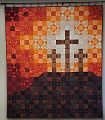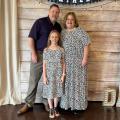Need help with machine binding please!!!
#11
Power Poster
Join Date: May 2009
Location: NY
Posts: 10,590
When I machine sew binding I also do the faux flange Tartan suggested. I do press it in half. The flange technique calls for stitching to the back first then folding over to the front. I then glue baste in place with washable school glue and set it with a hot iron. I use a walking foot for all steps. I don't have any issues.
Here is a good tutorial from the QB by Charismah.
Quick Machine Binding with Flange
Here is a good tutorial from the QB by Charismah.
Quick Machine Binding with Flange
#15
Power Poster
Join Date: Dec 2008
Location: Western Wisconsin
Posts: 12,930
The waviness probably comes from having the binding fabric stretch when you sew the second side. If you think of a straight line running across your binding, if one end of the line on one side of the quilt gets sewn down beyond the end of the line on the opposite side of the binding, the binding will not be evenly turned and you will get ripples or waves. Clear as mud? Here are the techniques I use to get perfect machine binding.
(1) I do not cut the edge of the quilt. I mark the "virtual" edge of the quilt with a permanent marker, and use this line as if it were my cutting line. This helps for a variety of reasons.
(2) Starch the binding fabric before cutting, especially if the fabric was pre-washed. It doesn't have to be terribly heavy starch; even simple spray starching helps. It helps the binding not stretch while you are working with it.
(3) I do not press the binding in half. It seems counter-intuitive, but binding actually works better if you do not press in half. The reason is because it rolls better over the edge. I did not believe this until I tried it.
(4) I don't always use a walking foot. Having a "virtual" cut edge instead of a real cut edge makes the edge easier to control whether using a walking foot or not.
(5) Binding goes on top when sewing, for obvious reasons. I hold the binding up above the quilt sandwich and keep it nice and taut while sewing. This ensures that I do not sew more binding than necessary to the quilt sandwich. It's better to have more quilt than binding, so let the feed dogs gather the quilt while sewing to the taut binding.
(6) After machine sewing the binding on one side, I take it to the ironing board and iron the binding away from the quilt sandwich. You would not believe how much this helps!
(7) At this point I can cut the quilt sandwich down to size. Be *very* careful on corners; do *not* cut through the binding at corners. I mindlessly trimmed the binding at a corner along with the quilt sandwich and ended up with holes in the binding. I experiment a little before deciding how wide to cut the quilt sandwich, testing to see how much I need to cut in order to get the binding to roll and be full without being over-stuffed.
I experiment a little before deciding how wide to cut the quilt sandwich, testing to see how much I need to cut in order to get the binding to roll and be full without being over-stuffed.
(8) I go back to the ironing board and use Elmer's white washable school glue and my iron to glue-baste the binding to the right side of the quilt. This allows me to secure the entire binding evenly along the edge. It takes a little time but, when I take the quilt to the sewing machine, the final sewing goes much faster because I do not need to struggle with the quilt making sure the fold is accurate.
(9) I like to use a decorative stitch on the right side of the quilt. It helps a *lot* if you can choose a decorative stitch that does not have a center line. Too dense a decorative stitch will make the stitching very slow. My favorite so far is a feather stitch that does not have a line down the center. This website shows a lot of machine feather stitch variations that do not have the center line: http://loopylace.com/anniescrazyworld/?cat=16 . My old Bernina 1230, which I love, does not have this kind of stitch. Its feather stitch goes out to both sides of a center line. The problem with center lines is that any deviation from the edge of the binding shows. With the decorative stitches that do not have a center line you can go faster and small deviations do not show.
Hope this helps!
(1) I do not cut the edge of the quilt. I mark the "virtual" edge of the quilt with a permanent marker, and use this line as if it were my cutting line. This helps for a variety of reasons.
(2) Starch the binding fabric before cutting, especially if the fabric was pre-washed. It doesn't have to be terribly heavy starch; even simple spray starching helps. It helps the binding not stretch while you are working with it.
(3) I do not press the binding in half. It seems counter-intuitive, but binding actually works better if you do not press in half. The reason is because it rolls better over the edge. I did not believe this until I tried it.
(4) I don't always use a walking foot. Having a "virtual" cut edge instead of a real cut edge makes the edge easier to control whether using a walking foot or not.
(5) Binding goes on top when sewing, for obvious reasons. I hold the binding up above the quilt sandwich and keep it nice and taut while sewing. This ensures that I do not sew more binding than necessary to the quilt sandwich. It's better to have more quilt than binding, so let the feed dogs gather the quilt while sewing to the taut binding.
(6) After machine sewing the binding on one side, I take it to the ironing board and iron the binding away from the quilt sandwich. You would not believe how much this helps!
(7) At this point I can cut the quilt sandwich down to size. Be *very* careful on corners; do *not* cut through the binding at corners. I mindlessly trimmed the binding at a corner along with the quilt sandwich and ended up with holes in the binding.
 I experiment a little before deciding how wide to cut the quilt sandwich, testing to see how much I need to cut in order to get the binding to roll and be full without being over-stuffed.
I experiment a little before deciding how wide to cut the quilt sandwich, testing to see how much I need to cut in order to get the binding to roll and be full without being over-stuffed.(8) I go back to the ironing board and use Elmer's white washable school glue and my iron to glue-baste the binding to the right side of the quilt. This allows me to secure the entire binding evenly along the edge. It takes a little time but, when I take the quilt to the sewing machine, the final sewing goes much faster because I do not need to struggle with the quilt making sure the fold is accurate.
(9) I like to use a decorative stitch on the right side of the quilt. It helps a *lot* if you can choose a decorative stitch that does not have a center line. Too dense a decorative stitch will make the stitching very slow. My favorite so far is a feather stitch that does not have a line down the center. This website shows a lot of machine feather stitch variations that do not have the center line: http://loopylace.com/anniescrazyworld/?cat=16 . My old Bernina 1230, which I love, does not have this kind of stitch. Its feather stitch goes out to both sides of a center line. The problem with center lines is that any deviation from the edge of the binding shows. With the decorative stitches that do not have a center line you can go faster and small deviations do not show.
Hope this helps!
Last edited by Prism99; 11-28-2017 at 12:48 PM.
#16
Prism, as usual, you have been most helpful! The only thing I can't do is the first step. MSQC already trimmed the quilt. I can see how I've made a lot of mistakes along the way. Thank you so much!
#18
Hi SusieQ -
I posted this tutorial: How I machine bind but unfortunately didn't take pics when I put the front side on.
After I put the back side on, I press the binding "out" from the back side. I start sewing the front in the same place that I started the back, using a 3.0" or 3.5" stitch length. I fold over about 12" and make sure it isn't stretched or off-grain. I sew that section down, then repeat the process. When I get to the corners, I make sure the miter faces the opposite direction from the other side. That really does help. I got that tip from a Martelli Notions video on YouTube.
Good luck and I'm looking forward to seeing your finished quilt. That one is on my list.
I posted this tutorial: How I machine bind but unfortunately didn't take pics when I put the front side on.
After I put the back side on, I press the binding "out" from the back side. I start sewing the front in the same place that I started the back, using a 3.0" or 3.5" stitch length. I fold over about 12" and make sure it isn't stretched or off-grain. I sew that section down, then repeat the process. When I get to the corners, I make sure the miter faces the opposite direction from the other side. That really does help. I got that tip from a Martelli Notions video on YouTube.
Good luck and I'm looking forward to seeing your finished quilt. That one is on my list.
#19
Power Poster
Join Date: Dec 2008
Location: Western Wisconsin
Posts: 12,930
This glue also works for piecing when you need absolutely accurate seam matching. In that case, I take the pieces to the ironing board, push a pin straight down through both pieces where they need to match, lift up the top seam allowance so I can place a tiny drop of glue in the seam, place a hot iron on top of the seam to quickly dry the glue, remove the pin, and take to the sewing machine.
#20
Power Poster
Join Date: Dec 2008
Location: Western Wisconsin
Posts: 12,930
One more thing I should mention about binding. It is usually not necessary to pre-wash binding fabric, especially if you are doing straight-grain binding. If you are doing bias binding, though, you may want to pre-wash for shrinkage. On one quilt I decided to do bias binding using an unwashed Michael Miller black fabric. The binding went on beautifully but, after the quilt was washed, the binding fabric shrank a lot, creating ripples and waves along all of the edges. Bearisgray has mentioned how much MM black fabric shrank when she pre-washed it. So I think this caution has to do both with the fact that this is a fabric that has a lot of shrinkage, plus the bias cut probably makes the shrinkage even worse. None of my other bindings have shrunk like that even though they were not pre-washed; however, none were MM black and all were straight-grain bindings.
Thread
Thread Starter
Forum
Replies
Last Post
craftybear
Links and Resources
0
11-03-2011 01:23 PM
craftybear
Links and Resources
3
05-07-2011 10:05 AM
craftybear
Links and Resources
3
12-25-2010 09:49 PM







